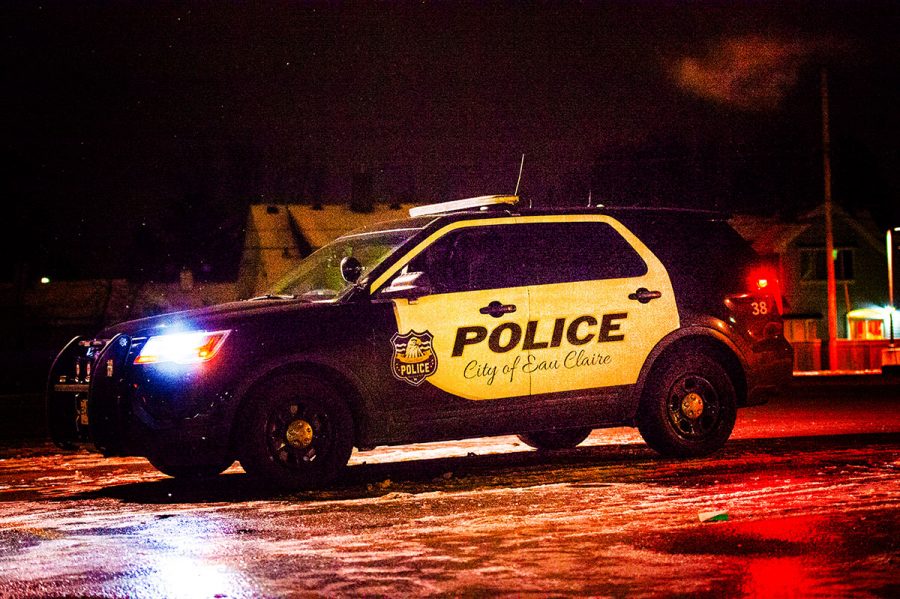Ineffective crime record keeping leaves grey area for local law enforcement
UW-Eau Claire Campus Police reports leave sizable blind spots, raise concerns for evaluating officer performances
Photo by Kelsey Smith
UW-Eau Claire Campus Police, along with the Eau Claire Police Department (cruiser pictured) are among five law enforcement agencies in Eau Claire County. All adhere to the UCR crime data program.
December 8, 2016
An investigation into the operations of campus police highlighted deficiencies in the protocols of local law enforcement in Eau Claire County and agencies across the state.
In mid-October English professor Stephanie Farrar penned her letter to the Leader-Telegram regarding incidents involving her Salvadorian husband, English professor Jose Alvergue, his parents and a campus police officer — a letter that prompted many online readers to express solidarity with her outrage.
It led to heightened scrutiny regarding actions of local law enforcement, especially campus police that interact with a diverse campus community on a consistent basis.
The officer involved in the Alvergue incident was exonerated of any wrongdoing, according to an email by campus police Lt. Jay Dobson.
UW-Eau Claire Chief of Police David Sprick praised the officers under his command in terms of their cultural sensitivity.
“If any police officers get it, it’s our police officers,” Sprick said. “They’re more open-minded, more sensitive. In this environment, we just have that much more experience dealing with people from other cultures.”
However, there are opposing opinions in regards to the five law enforcement agencies in the area, which includes the campus police.
Dennis Beale, student services coordinator at Blugold Beginnings and the Office of Multicultural Affairs, said he advises students of color to wear clothing with UW-Eau Claire insignias or decals in order to gain institutional protection against biased actions by local law enforcement.
Collis McCloud, a senior business management student and an African-American, said ignorance on the part of local officers leads them to operate under cultural stereotypes. These false assumptions result in instances where McCloud and his friends have been tailed, stopped or searched by police officers on multiple occasions.
“I don’t think they’re trained well enough to handle those situations,” McCloud said. “You know how young black males are portrayed in the media and if it’s the only thing they can go based off of — I sometimes understand why they do what they do — but as an entire institution they should be trained in cultural knowledge.”
For Ahmadou Mfinanga, an African-American economics student, originally from the Milwaukee area, where he drives or when he visits certain areas of the city are determined by factors like the time of day or whether he’s in the company of Caucasian friends.
Otherwise, Mfinanga said, he’s been repeatedly tailed, stopped and questioned by local police and in many cases, officers assumed criminal activity on his part and his minority friends without evidence of an infraction.
“Out here in Eau Claire, it happens way more (than Milwaukee),” he said. “At this point, I’m used to it. It comes with being in Eau Claire. It is what it is. Sometimes, if you question them and they take that as a hostile situation, they do extra stuff, unnecessary stuff.”
Victoria Vu, an undeclared freshman student, said it’s common among Hmong students to face situations where they don’t feel local law enforcement is protecting them or that police officers don’t treat them as members of the community.
“There was an incident where (officers) didn’t think (a friend) was a student of Eau Claire and asked her ‘Why are you here?’ She had to go back to her dorm to show them her student I.D.,” Vu said. “They shouldn’t assume so quickly they’re not students.”
Beyond anecdotes, it is nearly impossible to make concrete judgements on the performance of local agencies like the Eau Claire campus police.
According to reports compiled between Dec. 2012 and Nov. 2016, individuals of minority descent accounted for 6.9 percent of arrests and citations issued by campus police, which is less than the roughly 10 percent non-white population indicated in both the university registry and the 2010 National Census Data for the city of Eau Claire.
However, antiquated protocols in the Uniform Crime Report (UCR) — the statewide crime data program utilized by around 400 agencies since the 1930s — indicate this crime data is flawed. In the UCR data sets, only four racial demographics are identified: White, Black, Asian/Pacific Islander and Native American/Alaska Native.
As a result, how groups like Middle Easterners are categorized or whether the UCR differentiates between people of South Asian or East Asian descent is unclear. In the case of Hispanics/Latinos, these individuals are recorded in the system as white.
While identity in most arrests and citations are typically verified by a form of I.D. such as a driver’s license, Dobson said that when in doubt, he advises officers to enter the ethnicity of the individual as white.
That, coupled with incomplete and error-marred documentation in the campus police archives, makes it difficult for the actions of officers to be properly evaluated.
It should also be noted that, unless an arrest is made or a citation is issued (or, essentially when there is a verifiable crime or infraction), the race of the individual is rarely recorded. This represents an enormous blind spot in the data. While 2034 arrests and citations were recorded between Dec. 2012 and Nov. 2016 by campus police, Dobson said incident reports — or any time an officer makes an official action or inquiry — amount to roughly 1300 reports each year.
What separates legitimate police work from unwarranted tailing, stops, questioning, searches or general harassment is whether the officer’s behavior is backed by a justified cause.
Sprick said determining whether an officer’s motives are justified or not is difficult, as curiosity — or “fishing” — by an officer can either be perceived as unwarranted behavior or insightful depending on the situation. There are a number of variables at play with every interaction.
“I think it’s normal, it’s typical, it’s professional contact,” Sprick said. “It’s just trying to verify everything is proper, that nothing inappropriate or illegal is going on.”
When events take a turn for the worse, Sprick said, typically they are indicative of cultural misconceptions that plague society as a whole, affecting a spectrum of professions, of which law enforcement is just one.
In all communications, Sprick said UW-Eau Claire Campus Police officers draw upon a number of cultural competency training courses and adhere to a professional communication model, one that emphasizes restraint, respect and impartiality.
A review of the “Professional Communication Guide” reveals comparatively little content in regard to the topic of “overcoming interpersonal barriers.” Of the 140 pages devoted to proper communication, only a few paragraphs detail approaches to intercultural interactions and there are no references to what or what doesn’t constitute suspicious behavior.
That, sociology professor Peter Hart-Brinson said, may be the dividing line between justified cause and racial profiling. While there are clearly defined methods for engaging suspicious individuals, determining whether an individual is suspicious in the first place is often an instinctive snap judgement, one commonly based on preconceived notions and unconscious biases the officer may not be aware of.
“We immediately look for all the visual and other contextual clues to try to interpret what’s happening. This is just normal human behavior,” Hart-Brinson said. “The difference between police and the rest of us is that they’re job, in interpretation, is specifically to prevent crime, to prevent dangerous situations. They’re predisposed to be on the lookout for things that don’t fit, things that don’t look right.”
Skin color is not only far and away the strongest and most influential visual marker, it also carries cultural baggage that is attached with this association, Hart-Brinson said. This is especially strong in American society, where skin color is historically associated with certain attributes or behaviors.
It’s a widespread issue that extends far beyond law enforcement. Hart-Brinson said roughly 75 percent of whites fail implicit bias tests regarding race — examinations that determine snap judgments or knee-jerk reactions people display in situations where there isn’t enough time to rationalize their actions.
“Every piece of evidence we have shows us there is still personal, explicit discrimination in all sectors of our society,” he said.
In essence, police officers are in a position where they are constantly expected to make snap judgements and like most people, they’re susceptible to interpreting the situation incorrectly.
While not overtly racist, Hart-Brinson said, many police officers act in a way that reflects a combination of unconscious bias and systematic prejudice.
For law enforcement to overcome implicit biases, McCloud said officers should interact with communities of color outside of their official capacities to better connect and understand people different from them.
Hart-Brinson said he advocates training to address the issue. By identifying these preconceived notions and assumptions, police officers are better equipped to make the right determinations in difficult situations.
“Denial doesn’t help,” he said. “Police officers can rightfully say ‘Well, I’m not racist. I haven’t done anything.’ But just because you didn’t do anything explicitly doesn’t mean you can deny racism is there. This is bigger than interpersonal differences.”


